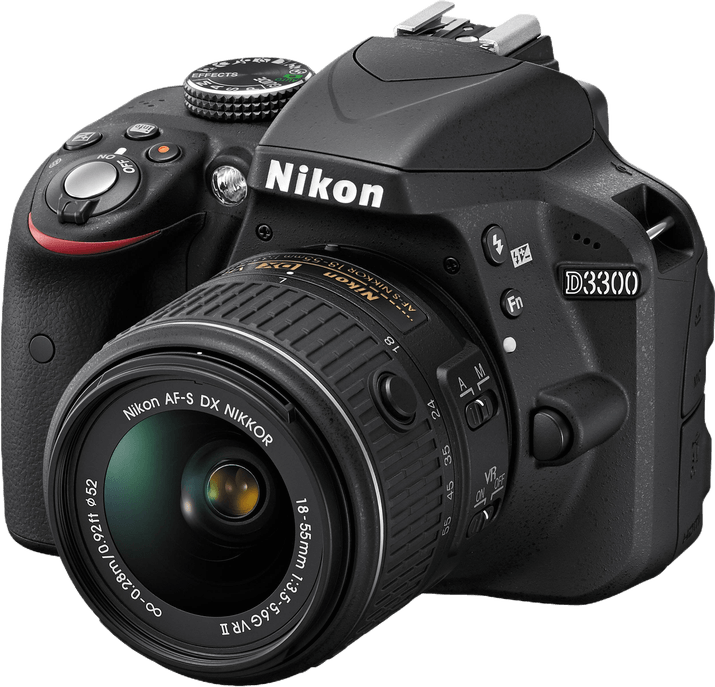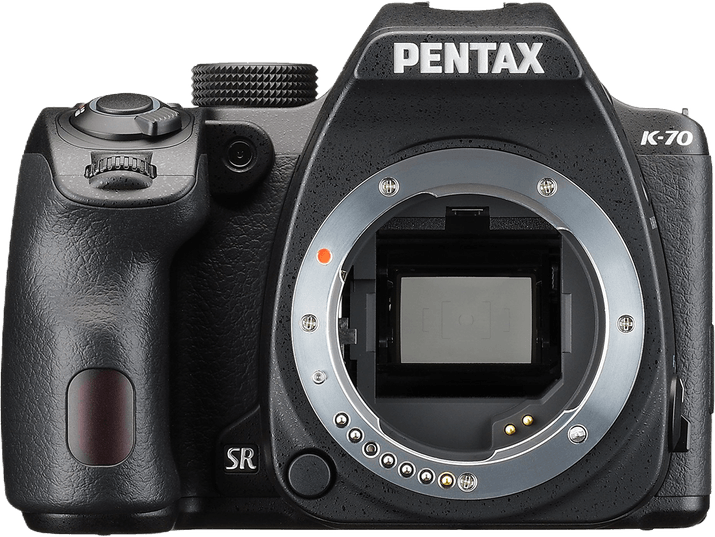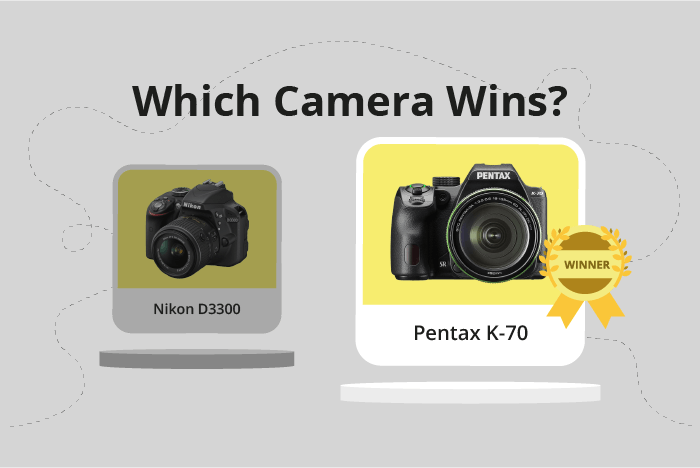Nikon D3300 vs Pentax K-70 Comparison
Nikon D3300

Pentax K-70

The Pentax K-70 outperforms the Nikon D3300 with a score of 69/100 compared to 55/100. Both cameras are DSLRs, announced in 2016 and 2014 respectively, with an initial launch price of $650. They share similarities in size, with the Nikon D3300 measuring 124 x 98 x 76mm and the Pentax K-70 at 126 x 93 x 74mm.
The Pentax K-70’s higher score reflects its superior performance, offering more advanced features and capabilities. However, the Nikon D3300 has an advantage in terms of weight, being lighter at 430g compared to the Pentax K-70’s 688g.
Taking these factors into account, the Pentax K-70 emerges as the better camera for those seeking enhanced performance, while the Nikon D3300 may appeal to those who prioritize a lighter and more compact camera.
Nikon D3300 vs Pentax K-70 Overview and Optics
The Pentax K-70 triumphs over the Nikon D3300 in optics with a score of 74/100 compared to the Nikon’s 64/100. Both cameras possess common specifications, including a 24-megapixel CMOS sensor, APS-C sensor size, and compatibility with their respective lens mounts, the Nikon F DX and Pentax KAF2.
The Pentax K-70 outshines the Nikon D3300 in several aspects. With a faster shooting speed of 6 compared to the Nikon’s 5, the K-70 allows for capturing more frames in a shorter time. The K-70 also boasts a higher DXOMARK score for its sensor at 88, while the D3300 scores 82, implying superior image quality. Additionally, the K-70 features image stabilization, which the D3300 lacks, enabling sharper images in various shooting conditions.
On the other hand, the Nikon D3300 has a slight advantage in megapixels, offering 24.2 compared to the Pentax K-70’s 24. However, this difference is minimal and unlikely to impact image quality significantly. The D3300 also utilizes the Expeed 4 processor, while the K-70 has the Prime MII processor, but the effect of these processors on image quality remains unclear.
Taking these factors into account, the Pentax K-70 emerges as the superior camera in terms of optics, with a faster shooting speed, higher DXOMARK score, and image stabilization. The Nikon D3300 holds a marginal advantage in megapixels but falls short in other areas. Therefore, for photographers prioritizing optics, the Pentax K-70 is the preferable choice.
Nikon D3300 vs Pentax K-70 Video Performance
The Pentax K-70 outperforms the Nikon D3300 in video capabilities, scoring 70/100 compared to the D3300’s 56/100. Both cameras share common specifications in video recording, such as Full HD video resolution (1920 x 1080) and a maximum video frame rate of 60fps. Despite these similarities, there are key differences that set the Pentax K-70 ahead.
The Pentax K-70 offers a built-in time-lapse functionality, which the Nikon D3300 lacks. This feature allows users to create captivating time-lapse videos without the need for additional software or accessories. The K-70’s higher video score reflects this advantage, making it a better choice for those interested in producing time-lapse content.
The Nikon D3300, while scoring lower in video capabilities, still offers respectable Full HD video recording and a 60fps maximum frame rate. However, it does not surpass the Pentax K-70 in any significant aspect within the realm of video recording.
Considering the higher video score and the presence of built-in time-lapse functionality, the Pentax K-70 stands out as the better option for video enthusiasts. On the other hand, the Nikon D3300 remains a viable choice for those who prioritize other aspects of photography and may not require advanced video features. Ultimately, the choice between the two cameras depends on the user’s specific needs and preferences in video recording capabilities.
Nikon D3300 vs Pentax K-70 Features and Benefits
The Pentax K-70 outperforms the Nikon D3300 in features with a score of 68 to 41. Both cameras share a 3-inch screen with a resolution of 921,000 dots and neither has a touchscreen. However, the Pentax K-70 boasts several advantages over the Nikon D3300.
The K-70 has a flip screen, which provides more flexibility when composing shots from various angles. This feature is absent in the D3300. Additionally, the K-70 is equipped with GPS, allowing photographers to geotag their images for easy organization and location-based searches. The Nikon D3300 lacks this feature.
Connectivity-wise, the Pentax K-70 surpasses the Nikon D3300 as it has both Wi-Fi and Bluetooth capabilities, enabling users to transfer images wirelessly and control the camera remotely using a smartphone app. The D3300 does not have these features, making it less convenient for sharing photos and controlling the camera from a distance.
Despite the lower feature score, the Nikon D3300 has a few advantages. It is lighter and smaller than the K-70, making it more portable for those who prefer a compact camera. Additionally, the D3300 is often less expensive than the K-70, making it a more budget-friendly option for beginner photographers.
Considering the advantages and disadvantages of each camera, the Pentax K-70 is a better choice for photographers who prioritize features such as a flip screen, GPS, and wireless connectivity. On the other hand, the Nikon D3300 may cater to those who prefer a lighter, more compact camera with a lower price tag.
Nikon D3300 vs Pentax K-70 Storage and Battery
The Nikon D3300 outperforms the Pentax K-70 in storage and battery, scoring 32/100 compared to the Pentax K-70’s 24/100. Both cameras share common specifications, such as having one memory card slot, accepting SD/SDHC/SDXC memory cards, and lacking USB charging capabilities.
The Nikon D3300’s superior battery life sets it apart, offering 700 shots per charge compared to the Pentax K-70’s 410 shots. This longer battery life makes the D3300 more reliable for extended shooting sessions. In addition, the D3300 uses the EN-EL14a battery type, while the K-70 uses the D-LI109 battery.
However, the Pentax K-70 has an advantage in memory card compatibility, as it supports UHS-I cards, allowing for faster read and write speeds. This feature is particularly useful for photographers who need quicker access to their photos.
In the end, the Nikon D3300’s longer battery life makes it a better choice for those who prioritize extended shooting capabilities. The Pentax K-70’s compatibility with UHS-I cards may attract photographers who require faster memory card performance.
Nikon D3300 vs Pentax K-70 – Our Verdict
Are you still undecided about which camera is right for you? Have a look at these popular comparisons that feature the Nikon D3300 or the Pentax K-70:

